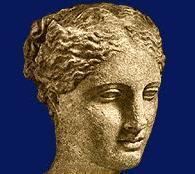Books Anyte | ||
 | ||
People also search for Asclepiades of Samos, Antipater of Sidon, Agathias | ||
Anyte of Tegea (Greek: Ἀνύτη Τεγεᾶτις, Anýtē Tegeâtis; fl. early 3rd century BC) was an Arcadian poet. She is one of the nine outstanding ancient women poets listed by Antipater of Thessalonica in the Palatine Anthology. Anyte was known for her epigrams, and she introduced rural themes to the genre.
Anyte was from Tegea in Arcadia. No reliable information about her life survives, and she can only be approximately dated by the style of her work. Only one story about Anyte's life is preserved. Pausanias claims that Anyte was once visited by the god Asclepius while she was asleep, and told to go to Naupactus to visit a certain blind man there. On doing so, the man was cured, and he built a temple to Asclepius. Though little is known about Anyte's life, more of her poetry survives than any other ancient Greek woman, with the exception of Sappho.
24 epigrams attributed to Anyte survive today. One of these is preserved by Julius Pollux; the remainder are part of either the Palatine or Planudean Anthology. Of these, Kathryn Gutzwiller considers that 20 of these were genuinely composed by Anyte. It is likely that Anyte compiled a book of her poetry from her epigrams. Anyte's poetry is often interested in women and children, and Gutzwiller argues that it was deliberately composed in opposition to traditional epigrams, composed by an anonymous author from a masculine and urban perspective. Accordingly, of five epitaphs written by Anyte which survive, only one marks the death of a young man, as was traditional in the genre; the remaining four all commemorate women who died young.
According to some sources, Anyte was the leader of a school of poetry and literature on Peloponnesus, which also included the poet Leonidas of Tarentum.
She was the first to write epitaphs for animals, and one of the first known to write vivid descriptions of untamed nature. The following example (translated by Marilyn B. Skinner) is of a statue of Aphrodite, often known as the "Cyprian" because of her origin:
This is the site of the Cyprian, since it is agreeable to herthat she may make the voyage good for sailors. Around her the sea